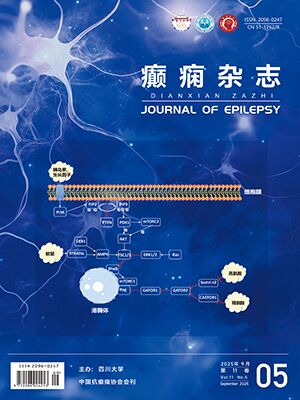| 1. |
Irani SR, Gelfand JM, Al-Diwani A, et al. Cell-surface central nervoussystem autoantibodies: clinical relevance and emerging paradigms. Ann Neurol, 2014, 76(2): 168-184.
|
| 2. |
Leypoldt F, Armangue T, Dalmau J. Autoimmune encephalopathies. Ann N Y Acad Sci, 2014, 1338(7): 94-114.
|
| 3. |
Irani SR, Alexander S, Waters P, et al. Antibodies to Kv1 potassium channel-complex proteins leucine-rich, glioma inactivated 1protein and contactin-associated protein-2 in limbic encephalitis.Morvan's syndrome and acquired neuromyotonia. Brain, 2010, 133(11): 2734-2748.
|
| 4. |
Lai M, Huijbers MG, Lancaster E, et al. Investigation of LGI1 as theantigen in limbic encephalitis previously attributed to potassium channels: a case series. Lancet Neurol, 2010, 9(2): 776-785.
|
| 5. |
Irani SR, Bera K, Waters P, et al. N-methyl-D-aspartate antibody encephalitis: temporal progression of clinical and paraclinical observations in a predominantly non-paraneoplastic disorder of both sexes. Brain, 2010, 133(7): 1655-1667.
|
| 6. |
Dalmau J, Gleichman AJ, Hughes EG, et al. Anti-NMDA-receptorencephalitis: case series and analysis of the effects of antibodies. Lancet Neurol, 2008, 7(2): 1091-1098.
|
| 7. |
Irani SR, Michell AW, Lang B, et al. Faciobrachial dystonic seizuresprecede Lgi1 antibody limbic encephalitis. Ann Neurol, 2011, 69(4): 892-900.
|
| 8. |
Irani SR, Stagg CJ, Schott JM, et al. Faciobrachial dystonic seizures:the influence of immunotherapy on seizure control and prevention ofcognitive impairment in a broadening phenotype. Brain, 2013, 136(8): 3151-3162.
|
| 9. |
Majoie HJ, de Baets M, Renier W, et al. Antibodies to voltage-gatedpotassium and calcium channels in epilepsy. Epilepsy Res, 2006, 71(10): 135-141.
|
| 10. |
McKnight K, Jiang Y, Hart Y, et al. Serum antibodies in epilepsy andseizure-associated disorders. Neurology, 2005, 65(6): 1730-1736.
|
| 11. |
Brenner T, Sills GJ, Hart Y, et al. Prevalence of neurologic autoantibodies in cohorts of patients with new and established epilepsy. Epilepsia, 2013, 54(5): 1028-1035.
|
| 12. |
Suleiman J, Wright S, Gill D, et al. Autoantibodies to neuronal antigens in children with new-onset seizures classified according to therevised ILAE organization of seizures and epilepsies. Epilepsia, 2013, 54(11): 2091-2100.
|
| 13. |
Quek AM, Britton JW, McKeon A, et al. Autoimmune epilepsy: clinical characteristics and response to immunotherapy. Arch Neurol, 2012, 69(9): 582-593.
|
| 14. |
Bien CG. Value of autoantibodies for prediction of treatment responsein patients with autoimmune epilepsy: review of the literature andsuggestions for clinical management. Epilepsia, 2013, 54(Suppl. 2): 48-55.
|
| 15. |
Arts WF, Geerts AT, Brouwer OF, et al. The early prognosis of epilepsy in childhood: the prediction of a poor outcome. The dutch study of epilepsy in childhood. Epilepsia, 1999, 40(7): 726-734.
|
| 16. |
Arts WF, Brouwer OF, Peters AC, et al. Course and prognosis of childhood epilepsy: 5-year follow-up of the dutch study of epilepsy in childhood. Brain, 2004, 127(8): 1774-1784.
|
| 17. |
Hauser WA, Anderson VE, Loewenson RB, et al. Seizurerecurrence after a first unprovoked seizure. N Engl J Med, 1982, 307(10): 522-528.
|
| 18. |
Callenbach PM, Jol-Van Der Zijde CM, Geerts AT, et al.Immunoglobulins in children with epilepsy: The dutch study of epilepsy in childhood. Clin Exp Immunol, 2003, 132(12): 144-151.
|
| 19. |
Stroink H, Brouwer OF, Arts WF, et al. The first unprovoked, untreated seizure in childhood: a hospital based study of the accuracy of the diagnosis, rate of recurrence, and long term outcome after recurrence. Dutch study of epilepsy in childhood. J Neurol Neurosurg Psychiatry, 1998, 64(7): 595-600.
|
| 20. |
Geerts A, Brouwer O, Stroink H, et al. Onset of intractability and its course over time: the Dutch study of epilepsy in childhood. Epilepsia, 2012, 53(4): 741-751.
|
| 21. |
Paterson RW, Zandi MS, Armstrong R, et al. Clinical relevance of positive voltage-gated potassium channel (VGKC)-complex antibodies: experience from a tertiary referral centre. J Neurol Neurosurg Psychiatry, 2014, 85(7): 625-630.
|
| 22. |
Hacohen Y, Singh R, Rossi M, et al. Clinical relevance of voltagegated potassium channel-complex antibodies in children. Neurology, 2015, 85(2): 967-975.
|
| 23. |
Beaudoin GM III, Lee SH, Singh D, et al. Culturing pyramidal neurons from the early postnatal mouse hippocampus and cortex. Nat Protoc, 2012, 7(3): 1741-1754.
|
| 24. |
Kaech S, Banker G. Culturing hippocampal neurons. Nat Protoc, 2006, 1(4): 2406-2415.
|
| 25. |
Zandi MS, Paterson RW, Ellul MA, et al. Clinical relevance of serum antibodies to extracellular N-methyl-D-aspartate receptor epitopes. J Neurol Neurosurg Psychiatry, 2015, 86(3): 708-713.
|
| 26. |
Hacohen Y, Wright S, Waters P, et al. Paediatric autoimmune encephalopathies: clinical features, laboratory investigations and outcomes in patients with or without antibodies to known central nervous system auto antigens. J Neurol Neurosurg Psychiatry, 2013, 84(4): 748-755.
|
| 27. |
Ramanathan S, Wong CH, Rahman Z, et al. Myoclonic status epilepticus as a presentation of caspr2 antibody-associated autoimmune encephalitis. Epileptic Disord, 2014, 16(3): 477-481.
|
| 28. |
Hacohen Y, Deiva K, Pettingill P, et al. N-methyl-D-aspartate receptor antibodies in post-herpes simplex virus encephalitis neurological relapse. Mov Disord, 2014, 29(2): 90-96.
|
| 29. |
Mohammad SS, Sinclair K, Pillai S, et al. Herpes simplex encephalitis relapse with chorea is associated with auto antibodies to N-Methyl-Daspartate receptor or dopamine-2 receptor. Mov Disord, 2014, 29(7): 117-122.
|
| 30. |
Hegde M, Lowenstein DH. The search for circulating epilepsy biomarkers. Biomark Med, 2014, 8(2): 413-427.
|




